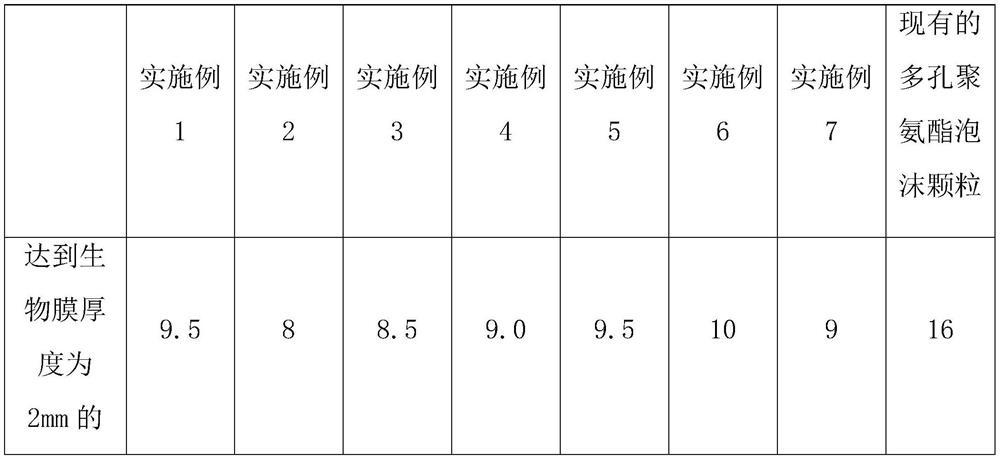A kind of porous polyurethane foam particle filler suitable for moving bed biofilm reactor and preparation method thereof
A moving bed biofilm, polyurethane foam technology, applied in chemical instruments and methods, sustainable biological treatment, biological water/sewage treatment, etc., can solve problems such as rare research on filler modification, and achieve good dispersion , Good uniformity and strong rigidity
- Summary
- Abstract
- Description
- Claims
- Application Information
AI Technical Summary
Problems solved by technology
Method used
Image
Examples
Embodiment 1
[0027] (1) Add cellulose microcrystals in 65% zinc chloride solution, and dissolve for 1 hour at 25°C with a stirring rate of 4000r / min, add carboxymethylcellulose sodium that accounts for 1wt% of the total amount of the system, and Process in an ultrasonic cell pulverizer with a power of 500W for 3s, with an interval of 5s, and a total working time of 15min. Continue to dissolve and filter to obtain nanocellulose sol.
[0028] (2) After mixing the nano-cellulose sol with a particle size of 800-1200nm and the silk protein solution with a molecular weight of 12-25kDa evenly, wherein the mass ratio of the nano-cellulose to the silk protein is 0.2:0.5, after freeze-drying, grind , forming ultrafine mixed powder of nanocellulose / regenerated silk fibroin with a particle size of 20-800 μm.
[0029] (3) In parts by weight, add 1-15 parts of nanocellulose / regenerated silk fibroin ultrafine mixed powder to 50 parts of polyether polyol, 10 parts of ethylene glycol, and 3 parts in a mass...
Embodiment 2
[0032] (1) Add cellulose microcrystals in 70% zinc chloride solution, dissolve 3h at 40°C with a stirring rate of 6000r / min, add carboxymethylcellulose sodium that accounts for 3wt% of the total system, and Process in an ultrasonic cell pulverizer with a power of 700W for 5s, with an interval of 8s, and a total working time of 20min. Continue to dissolve and filter to obtain nanocellulose sol.
[0033] (2) After mixing the nano-cellulose sol with a particle size of 800-1200nm and the silk protein solution with a molecular weight of 12-25kDa evenly, the mass ratio of the nano-cellulose to the silk protein is 3:2, after freeze-drying, grind , forming ultrafine mixed powder of nanocellulose / regenerated silk fibroin with a particle size of 20-800 μm.
[0034] (3) In parts by weight, add 15 parts of nanocellulose / regenerated silk fibroin ultrafine mixed powder into 70 parts of polyether polyol, 15 parts of ethylene glycol, 6 parts of amines with a mass ratio of 1:1 Add 75 parts of c...
Embodiment 3
[0037] (1) Add cellulose microcrystals in 65% zinc chloride solution, dissolve 3h at 40°C with a stirring rate of 4000r / min, add carboxymethylcellulose sodium that accounts for 1wt% of the total system, and Process in an ultrasonic cell pulverizer with a power of 700W for 3s, with an interval of 8s, and a total working time of 15min. Continue to dissolve and filter to obtain nanocellulose sol.
[0038] (2) After mixing the nano-cellulose sol with a particle size of 800-1200nm and the silk protein solution with a molecular weight of 12-25kDa evenly, the mass ratio of the nano-cellulose to the silk protein is 3:0.5, freeze-dried, and ground , forming ultrafine mixed powder of nanocellulose / regenerated silk fibroin with a particle size of 20-800 μm.
[0039] (3) In parts by weight, add 15 parts of nanocellulose / regenerated silk fibroin ultrafine mixed powder into 50 parts of polyether polyol, 15 parts of ethylene glycol, and 3 parts of amine with a mass ratio of 1:1 Add 60 parts...
PUM
| Property | Measurement | Unit |
|---|---|---|
| particle diameter | aaaaa | aaaaa |
| molecular weight | aaaaa | aaaaa |
| particle diameter | aaaaa | aaaaa |
Abstract
Description
Claims
Application Information
 Login to View More
Login to View More - R&D
- Intellectual Property
- Life Sciences
- Materials
- Tech Scout
- Unparalleled Data Quality
- Higher Quality Content
- 60% Fewer Hallucinations
Browse by: Latest US Patents, China's latest patents, Technical Efficacy Thesaurus, Application Domain, Technology Topic, Popular Technical Reports.
© 2025 PatSnap. All rights reserved.Legal|Privacy policy|Modern Slavery Act Transparency Statement|Sitemap|About US| Contact US: help@patsnap.com



